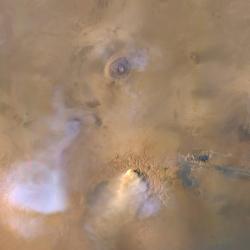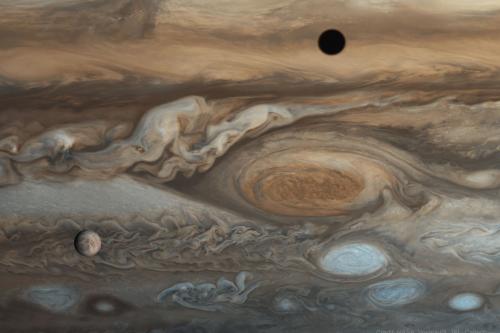Things are kicking into a higher gear in our MAJIS lab. A team of scientists and engineers from the Royal Belgian Institute for Space Aeronomy has been working for some time on the development of a characterisation facility for one of two detectors of a space instrument called MAJIS, planned to be launched on board the JUICE spacecraft to the Jupiter’s system in 2022. MAJIS is a French instrument under the scientific and technical responsibility of the “Institut d'Astrophysique Spatiale” (IAS, Orsay), under the supervision of the “Centre National d’Etudes Spatiales” (CNES) and the Italian Space Agency (ASI), with Belgian contributions from BIRA-IASB and ROB (Royal Observatory of Belgium), supported by BELSPO and PRODEX Office (ESA). This work package corresponds to the full characterisation of the VIS-NIR detector (for visible and near-infrared light). Recently, the flight model of the detector has been integrated in a thermal-vacuum chamber, and the teams started the characterisation campaign of the detector, to last until the beginning of September.
The JUICE mission
Jupiter is particularly interesting as an object of study, for it is the solar system’s largest gas giant, a type of planet of which we have found many orbiting around other stars. Jupiter has many moons, the four largest having been discovered centuries ago by Galileo : Io, Europa, Ganymede and Callisto. The latter three are icy moons, thought to contain oceans under their surfaces and possibly signs of life.
The JUpiter ICy moons Explorer (JUICE) will take about eight years to reach the gas giant, and will closely study Jupiter, Europa, Ganymede and Callisto for another three and a half years. The data that JUICE sends back to us will allow us to investigate how gas giants and their systems of moons are created, better understand what the icy moons are made of, and how these potentially habitable worlds were formed, not only in our solar system, but in other star systems as well.

The MAJIS instrument
The Moons And Jupiter Imaging Spectrometer (MAJIS) is a hyper-spectral (measuring many narrow bands in the electromagnetic spectrum) imaging spectrometer (extracting information from incoming light). It is designed to observe Jupiter’s atmosphere, its tropospheric cloud features, and to study the ices, organics and minerals on the surfaces of Jupiter’s icy moons, as well as their exospheres. MAJIS has two channels, VIS-NIR (visible and near-infrared) and IR (infrared) with which it will cover the visible and infrared wavelengths from 0.5 to 5.54 microns, with a spectral resolution of 3.66 – 6.51 nm.
What is a characterisation campaign and why is it necessary?
Imagine this: you want to study the planet Jupiter, but you cannot go there yourself, for many obvious reasons. You figure you need a spacecraft that can make that journey for you, and can send back all the information you want to know. You equip it with several sensitive instruments, like a spectrometer, which can measure different characteristics of Jupiter - and even its moons - as it orbits around them. However, once you receive the information from your spacecraft, how can you be sure that it is correct? There are no other spacecraft to validate the received data. Something might have gone wrong with the instruments during take-off, or during the long, cold voyage through space, or they might be influenced by other instruments on board, by radiation from the sun and many other things.
This is where tests and characterisation play a crucial role in the success of your space mission. All equipment must be tested for shocks, vibrations, extreme temperatures, etc. to make sure it won’t break. But your instruments, and in particular its detectors, also need to be characterised radiometrically, meaning you have to figure out whether the data that your instruments are sending back corresponds to reality, or whether it’s simply noise. You also need to know how they behave in certain extreme conditions that you will find in space.
Add to this that a journey to Jupiter can take up to 8 years! Imagine only finding out then that something isn’t quite right with your instruments, and having to start again (if you even have the time and money). Fully characterising your instruments in a tightly controlled environment is an indispensable step, because once the spacecraft is launched, there is very little you can do to address any issues.

No “one size fits all”
Each instrument is different, as it is specifically made for one mission. Known designs of previous instruments are usually built upon and improved, but the result is a piece of equipment that will behave quite differently and thus needs its own characterisation process. Developing and validating this process and characterisation bench for the MAJIS VIS-NIR detector is what the team at BIRA-IASB has been doing, under the supervision of the French institute IAS, with Dr. F. Poulet and Dr. Y. Langevin , respectively current and former principal investigators of this project.
Since last week, two teams from IAS have come to our Institute to work together: firstly, on the integration of the detector into the vacuum chamber, and secondly, to supervise the characterisation campaign that was fine-tuned by the BIRA-IASB team, the prime contractor for the VIS-NIR facility operations (responsible: Dr. D. Bolsée).
The BIRA-IASB and IAS teams are now continuing the campaign, which will be in two parts and will last until the beginning of September. The second part will consist of repeating some measurements once the detector is equipped with a special filter that will be used during the mission itself.
Run-up to the mission launch
In several months, the MAJIS VIS-NIR detector will be shipped to Italy, where it will be integrated into the MAJIS space instrument. The plan is for MAJIS to be integrated into the JUICE spacecraft in 2021, on schedule for a launch in September 2022.
Acknowledgements
The development and validation of the MAJIS VIS-NIR characterization bench was done in collaboration with “Institut d'Astrophysique Spatiale” (IAS, Orsay), under the supervision of the “Centre National d’Etudes Spatiales” (CNES) and with funding from BELSPO-PRODEX and ESA, and with the expertise support of ESA and CNES.
More info
- More about the JUICE mission, its scientific payload and objectives


